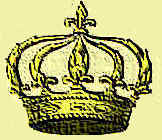All
the |
(Navigation bar
directly below.)
*******
© A.J. Goldsby, 2015.
(All rights reserved.)
****************
Click HERE
to see my
Chess Items.
****************
****************
Buy a book
from Amazon.com
(And help me out as well!)
****************
Click HERE
...
to see a list of the businesses that help to sponsor all of
my chess efforts.
Goldsby - Perciballi
(P.C.C. Quarterly, 2000)
___________________________________________________________________________________________________________
![]()
![]()
![]()
___________________________________________________________________________________________________________
![]()
A game from a recent (November) Pensacola Chess Club tournament in Pensacola, FL. I hope you enjoy my efforts. Be sure to drop me a line and tell me your thoughts! I'd love to know what you think of my work. (I also have plans for annotating all the games of the Kasparov-Kramnik match. If you have a famous GM game you'd like to see on these pages, drop me a line and let me know.)
A.J. Goldsby I (2235)
- Dr. John Perciballi
(1775)
[E62]
The Pensacola Fall Quarterly
(Played at: The People's First Community Bank on Creighton Rd.)
(Rd. 1.1), 04.11.2000
[ Annotator = A.J. Goldsby I ]
[ (c) 2000 ]
In the following game, my opponent - one of the members of the club -
plays very well. Both sides play well, and the game assumes a very unique nature. The
game, while definitely not perfect, is certainly interesting. It also has a very curious
ending.
The Pensacola Winter Quarterly. The time control was 45 moves in an hour and a half, then Sudden Death in 30 minutes. (This game was played in the 3-day schedule. The first round was Friday Evening. I did not want to play the two-day schedule, as it is more arduous and you get less time [on the clock] for your game.) I normally play 1.P-K4. But here, I did not want to play that now as my opponent plays the [Sicilian] Accelerated [Fianchetto] Dragon variation. John knows this line very well, probably better than me! He also plays it very well and has a very good "feel" for the line, as our dozens, (if not hundreds!); of blitz games at the chess club attest to. (John is a stalwart member of our club, [i.e., a regular], and currently serves as the P.C.C. President.) This was a good reason, or so I felt at the time, to avoid the variation entirely. In addition to this, I had just (at the last tournament), purchased a book on the Fianchetto Variation(s) of the King's Indian Defense, and after nearly two months of studying those lines; I felt I would be comfortable and knowledgeable in that position from either side of the board. In addition to this, I felt John would not know these lines as well as some of the other lines he plays and may not be as comfortable with them. I also felt to grow as a chess player, I needed to expand my horizons. To become an IM or better, I feel I should be able to play any (reasonable) opening move fairly well.
1.Nf3 Nf6; (We start off as a Reti, then transpose to a
K.I.D.)
2.g3 g6; 3.Bg2 Bg7; 4.d4 0-0; 5.0-0 d6; 6.c4 c6!?;
[ 6...Nc6; 7.Nc3 a6; 8.d5 Na5; 9.Nd2; would be, "The Panno
Variation."
(This line is also called "The Yugoslav Line, or "The
Yugoslav-Panno Variation," in Europe.)
6...Nbd7; 7.Nc3 e5; would be,
"The Old (Classical) Main Line." ]
7.Nc3 Na6!?;
Moving the Knight to the edge of the board like this is very risky. But it is not necessarily bad or unsound. It did have the advantage of avoiding practically all of my preparations. 7...Nbd7; followed by ...e5; could transpose back to the older, classical lines of the K.I.D. Fianchetto Variation.
(For readers who are interested in how these lines develop, please consult the following books: "Nunn's Chess Opening's," (N.C.O.) by GM John Nunn; "MCO-14," by GM Nick DeFirmian; or "The Fianchetto King's Indian," by GM Colin McNab.)
8.e4 Nd7; 9.Be3 e5; 10.Qd2 Nc7; 11.Rad1 a6;
12.Bh6, "+/="
White has a clear advantage, almost 60 one-hundredths of a pawn.
(According to
Fritz.)
12...Qe7; 13.Bxg7 Kxg7;
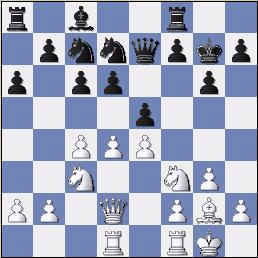
(The position after 13...Kxg7.)
Now the correct move is probably 14. a3. (With the idea of b4.) White decides on something a little more "creative," but not probably the most accurate.
14.h4!?, (Interesting, but probably not positionally justified.)
Trying to attack the Kingside, but probably NOT justified by the requirements of the position. (One of the greatest improvements I made was right after reading "Pawn Structure Chess," by GM Andy Soltis. In this book you learn you must respect the pawn structure and often a plan will not work in a particular pawn formation.) I started off as a pure tactical, attacking player. (As I progressed, I learned painfully - the hard way - that I could not attack in every game.) Here my old instincts get the better of me. I thought it was justified by the looseness of the Black King; the dark-square weakness on Black's King-side; and Black's inability to control the squares in front of his King. (But I wound up weakening my own King position!) Please understand, 14. h4!?, is not a bad move. Its just not the one that is required by the position!
According to the computer programs, two different lines lead to a very clear advantage for White. (These were probably the correct way to play the position.) Now better was: [ Either 14.a3 Qf6; 15.b4+/=; OR 14.dxe5 Nxe5; 15.Nxe5 dxe5; 16.Qe3+/=, (16.Qd6!?+/=) ], and both of these lines lead to a clear advantage for White.
14...Nb6; 15.b3 Bg4; 16.Qe3!?,
[ 16.dxe5! dxe5 17.Qd6+/=],
16...Nd7; 17.Rd2!?,
[Perhaps I should play 17.d5!? =, in order to keep the Black Knight out of d4.]
17...Bxf3; 18.Bxf3 Ne6; 19.d5 Nd4; 20.dxc6 bxc6; 21.Bg4,
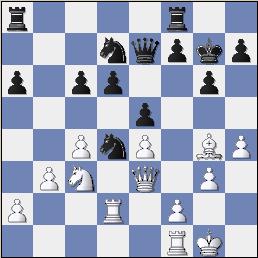
(The position after 21. Bg4.)
White has the tiniest of advantages, maybe + 0.10 - 0.15.
21...h5?!; (?)
{Diagram?}
Clearly
bad, according to the computers. White's advantage jumps significantly
now, based on the
various evaluations of the computer programs.
Best was simply 21...Nf6, followed by an
eventual ...d5.
(21...Rde8; was the same idea, but gives White the added option of
capturing on d7.)
(Sept.
2002 It took me two years to realize that Black may have planned out
the next few moves all in advance. Perhaps he thought that sinking the
Knight
into f3 won for him.)
[ 21...f5?!; (?) 22.exf5 gxf5; 23.Rxd4 Rae8; 24.Re1 fxg4;
25.Rxg4+ Kh8;
26.Rg5+/-. White is a clear pawn up, and is definitely better.]
22.Bh3 Rad8; 23.f4 Nf6; 24.f5 Kh7; 25.Rdf2,
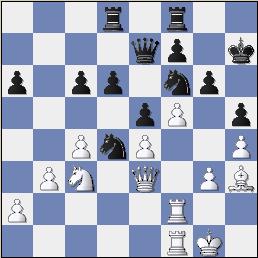
(The position after 25.Rdf2.)
Now White will have a very powerful and lasting pull, due to the pressure down the f-file.
25...Ng4;
Black may as well, he does not have much else.
26. Bxg4 hxg4; 27. f6 Qe6; 28. Kg2 Rh8;
[ After the game, Dr. Perciballi said he had looked at one line like: 28...d5!?; 29.exd5 cxd5; 30.Nxd5 Rxd5; 31.cxd5 Qxd5+; 32.Kh2 Nf3+; 33.Rxf3 gxf3; 34.Qxf3 e4; 35.Qe2 Rc8; 36.Rd1+/= , While this line is not fantastic for Black, it would have still been much better than the game! ].
29.
Ne2 Nf3;
[ 29...Nxe2?; 30.Rxe2, ("+/-")]
30.Rxf3!?,
{Diagram?}
White sacks
an exchange for play. The pressure down the f-file, the pawn on f6,
the weakness of the
Black King, the inability of Black's Rooks to easily the enter
the game, the
difficulty Black will have in organizing counterplay, the very broken
nature of Black's
Pawn Structure; ... I thought all these factors added up to the fact
that White will have
a good game. Or at least gave White some compensation for
the sacrificed exchange.
Another
factor that affected my decision was Black was running very short of time.
He wound up
coming very close to losing the game on time.
[ A draw would probably result from: 30.Ng1 Nd4; 31.Ne2 Nf3; 32.Ng1=.]
30...gxf3+; 31.Rxf3 c5?;
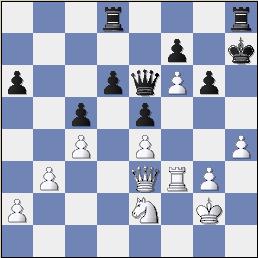
(Position after 31...c5?)
Very clearly a bad move. White advantage jumps nearly a point now.
Black just shut his own
Rooks out of play and gave White's Knight several
very nice squares. Most notable is the
square at d5 is now calling for an
invasion by the White Horsey!!
32.Ng1 Kg8;
33.Nh3 Qg4; 34.Nf2 Qe6; 35.Qd2!,
Covering both sides of the chess-board and
threatening
an invasion with my Queen at a5.
35...Rh5; 36.Qa5 Qc8; 37. Nd1!,
Going for the d5-square!!
37...g5?; (Possibly - "??")
No doubt this
move was caused, at least in part, by time pressure.
[An
alternative idea for Black was to play 37...Kh7. Black could then follow up
with
doubling his Rooks on the h-file, (...Rh8) and then play his King back to
g8.
Then after this careful preparation, the idea of the advance ...g5;
might just
work.]
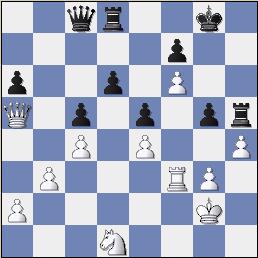
(The
position after 37...g5?;)
Black was not lost yet. But now he walks into a terrible pin.
38.Rf5 Kh7;
39.Qd2!, ("+/-")
{Diagram?}
White keeps the pressure on.
The Queen eyes the d6-square and also exerts strong pressure against g5.
Black is all tied up.
39...Qc6;
40.Nc3 Rg8; 41.Nd5 Kh8; 42.Qe3!, {Diagram?}
White improves the position of his
Queen just a little bit. He also guards e4.
Of course he should NOT play: 42. Ne7??, QxP/e4+; winning for Black.
42...Qb7;
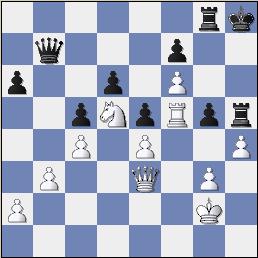
(The position after 42...Qb7.)
White
to play and win. What would you play? Here I thought for a very long time.
Every variation
(like taking the g-pawn), always ends in a move like ...QxP/e4+;
saving Black's bacon.
After thinking for nearly 20 minutes, I realized two things:
#1.)
Black is not going to run away.
#2.) I could just put my King somewhere
safe.
43.Kf2!!,
A wonderful waiting move! Now Black will never have the saving grace of QxP/e4, with check! If Black started a policy of just moving a piece back and forth, I was even considering marching my King all the way over to the Queen-side! The computer does NOT make this move, even after several minutes of thought!!
43...a5;
44.Ne7!, {Diagram?}
Now the computer sees what I was planning and considers the position
a win for
White.
44...Re8; 45.Rxg5 Rh7;
{Diagram?}
(Safe. No time forfeit ... for either player!)
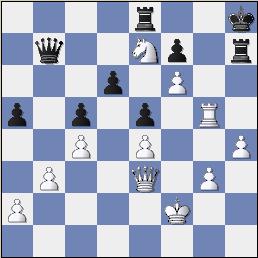
(The position after 45...Rh7.)
Time
control for both players. Black made his last 3-4 moves with only a few
seconds remaining
on his clock!!
(We were using John's Chronos digital clock. It was set for time delay, I
believe.)
46.Rg7!, ("+/-")
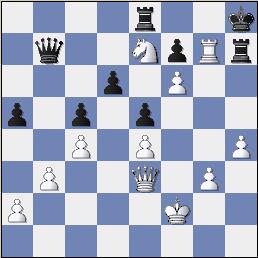
(Position after 46. Rg7!)
The computer sees this move practically right away. I only played it after [at least] 30 minutes of thought!! (Probably the amount of time I consumed was closer to 45 minutes. I took my time and tried to calculate every single variation to its logical conclusion.)
46...Rxe7!?; (Maybe "?!/?")
This move (46...Rxe7;), loses quickly.
[Probably Black had to play: 46...Rxg7;
I now had calculated the following variation:
47. fxg7+
Kxg7;
(
Black must capture the Pawn at g7. For instance: 47...Kh7??;
48. Nf5, and White is winning easily. {"+/-"} )
48. Qg5+!?, Not the best, but I missed a
quicker win in my
calculations.
***
Best
is: 48.Nf5+!, I saw this move, but did
not
correctly
calculate the ramifications of it.
48...Kh7; The best, Black
has few good choices now.
If 48...Kf6?!; 49.Qh6#!
It was this
trick that I missed,
(the mate) seeing only 49. Qg5+?, and the position may
not even be a win
anymore.
[Or:] 48...Kf8?!; 49.Qh6+ Kg8; 50.Qg7#; or 48...Kh8;
49.Qh6+
Kg8; 50.Qg7#; or 48...Kg8; 49.Qg5+ Kf8; 50.Qg7#
49. Qh6+
Kg8; 50. Qg7#.
***
(Returning
to the line I had actually calculated.)
48...Kf8;
(48...Kh7?; 49.Nf5 f6; (49...Rg8??; 50.Qh5# )
50.Qh5+, wins the Black
Rook.)
49. Nf5 f6; 50. Qh6+, The move I
saw when I played 46. Rg7.
( Also
winning was: 50.Qxf6+ Qf7 ;
{Not 50...Kg8?; 51.Qg6+ Kf8; 52.Qxe8+ Kxe8; 53.Nxd6+}
51.Qxf7+ Kxf7; 52.Nxd6+ Ke7; 53.Nxe8 Kxe8;
54.g4, ("+/-") with a very easily won K+P ending. )
50...Kg8; Black
has few choices hereabouts.
(Not 50...Kf7??;51.Qg7+ Ke6;52.Qxb7, and mate next move.)
51. Qg6+ Kf8; 52.
Qxe8+ Kxe8; 53. Nxd6+, winning
the
Black Queen. And definitely not 46...Rh5?; 47.Ng6+!, fxg6;
48.RxQ/b7, ["+/-"] getting Black's Q & winning easily for
White.]
(Now back to the actual game.)
47.Rxh7+
Kxh7; {Diagram?}
Now Black probably thought I would play 48. P/f6xR/e7, and Black can
capture the
Pawn with the Queen and struggle on.
48.Qg5!, (See the diagram just below.)
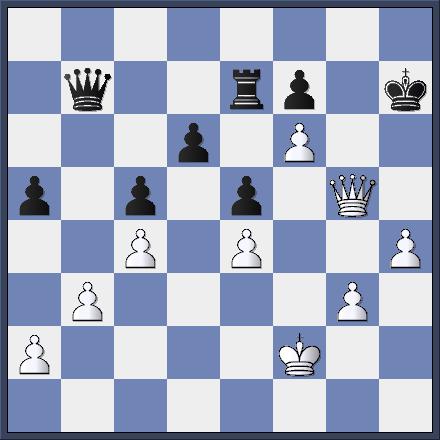
(The position after 48. Qg5!)
A
nice in-between move. (A "Zwischenzug." Instead of the expected recapture
of the
Rook, White makes another move. Any move that breaks the normal flow
of the game is a
zwischenzug.)
There is no defense to the mate,
so Black Resigns. 1-0
A very
entertaining and instructive game. (A tremendous struggle, too. Both sides
worked
very
hard during the game!) It was not perfect, but a lot of fun. This may
have been my first
tournament game ever on the White side of this variation! It
also took many,
many, many, hours of work
to prepare and present this game!
I hope you enjoyed it!!
***
1-0
***
(Game initially generated with ChessBase
8.0;
the tool EVERY SERIOUS chess-player MUST
have!!
Click here
to go to their website and order it!)
***
This
was the very first game I annotated (myself) in depth for my web page, at
least using ChessBase to initially generate
the HTML code. It was a HUGE learning curve and required well over a
hundred hours of work in FrontPage to make the game presentable. And on
July 14th, 2001, I went back and completely redid this game. Enjoy. And if you
enjoyed this game, drop me a line
and tell me about it.
I can also send you a copy of this game, if you like.
***
(There are link buttons at the top of the page.)
Copyright (c) A.J. Goldsby I
Copyright
(©) A.J. Goldsby, 1995 - 2008.
Copyright © A.J. Goldsby, 2009. All
rights reserved.

